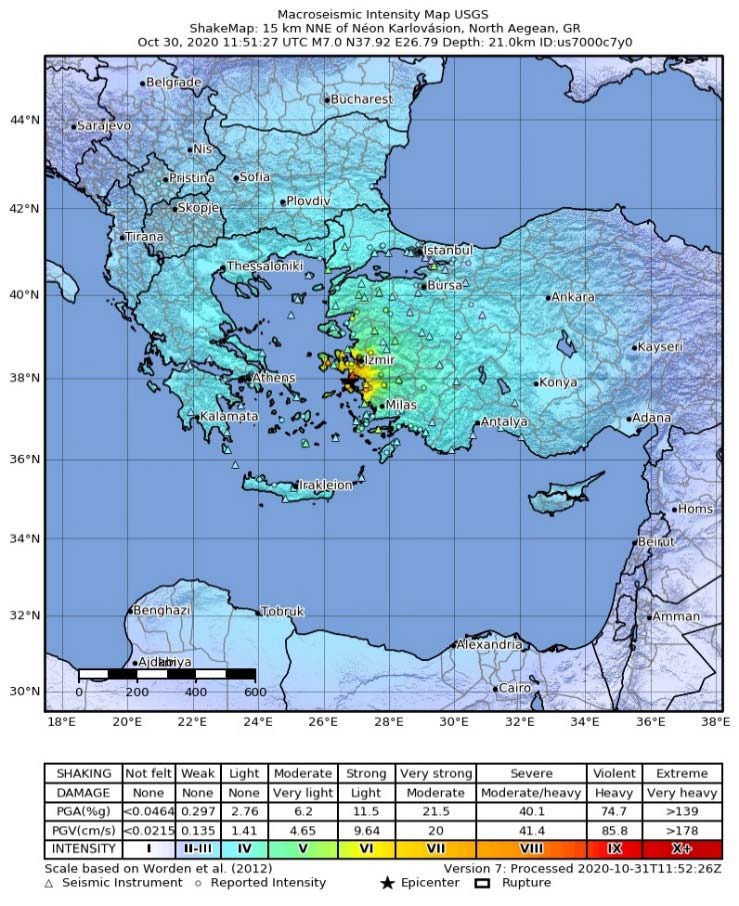On October 30, 2020, an Mw 7.0 earthquake struck near the Greek island of Samos and the western coast of Turkey in the Aegean Sea on a Friday at 2:51 p.m. local time (11:51 UTC). Near the epicenter of the Néon Karlovásion quake, peak ground acceleration was 0.5 g and the maximum MMI reached VII in some locations. The Turkish Disaster and Emergency Management Presidency (AFAD) reported that nearly 100 people lost their lives and around 1,000 were injured; most of the casualties occurred in Turkey’s third most populous city, Izmir. Greece experienced a few fatalities and 19 were injured.

More than 2,000 aftershocks have been recorded since the event with dozens up to Mw 4. At least 13 buildings, mostly residential mid-rises, collapsed and thousands were heavily damaged. There has been a global aid response and both countries’ leaders have stated support and readiness to provide mutual aid in the aftermath of this crisis.
Tectonic Setting
The Mediterranean is a very complex tectonic region where the African Plate is colliding and subducting beneath the Eurasian Plate. In the eastern half of the Mediterranean, there are a few features interacting with each other. The African Plate subducting beneath the Eurasian Plate is defined by the Hellenic Trench that bounds the Aegean Sea. In 2018 an Mw 6.8 occurred along this subduction zone along the western Greece coast. The Arabian Plate is moving northwest converging into the Anatolian Plate causing it to rotate and form a transform boundary with the European Plate. This boundary, called the North Anatolian Fault and very similar to California’s San Andreas Fault, is host to many large magnitude earthquakes. The most notable event of recent times being the Mw 7.6 1999 Izmit earthquake.
Southwest of the Anatolian Plate is the Aegean Sea microplate, which is bounded by the Hellenic Trench and encompasses the entire Aegean Sea region. This region has seen around 10 Mw 7.0 or greater earthquakes in the past century, including the October 30 event. Izmir, the city most impacted by this earthquake, has experienced large, destructive earthquakes such as this a few times before in recorded history, most notably the Mw 7.0 1688 Smyrna earthquake.
Last month’s Néon Karlovásion earthquake had a normal faulting type at a depth of 21 km. Unlike earthquakes that originate in the North Anatolian Fault or the Hellenic Trench, the earthquakes in the Aegean Sea are intraplate crustal events. These earthquakes do not occur because of plate boundary activity, but because of the subsidence due to the gravity of the elevated crust created from the convergence of two tectonic plates.
Tsunami Risk
Although the vast majority of this quake’s fatalities were caused by building collapse, one was due to the ensuing tsunami. We typically associate tsunamis with megathrust earthquakes that strike around the Pacific Ring of Fire, but tsunamis can be generated wherever earthquakes happen underwater. In this case many of the coastal towns around Turkey and Greece experienced tsunami flooding. Most places only had a few feet of flooding, but some, such as Akarca, Turkey, saw up to 19 feet (6 meters) of flooding. The Turkish Coast Guard Command reported that 22 boats sank from the floodwaters.
There has not been an official assessment of the total economic losses caused by this earthquake; however, in the AFAD report, 24 million Turkish Liras (USD 3 million) in aid has been sent to the earthquake zone. This is not the first, nor will it be the last, large earthquake to strike this part of the Mediterranean. In preparation for such future events, Turkey had updated their building codes for earthquake resilience in 2018.
Reliably assess and manage seismic risk with AIR earthquake models




